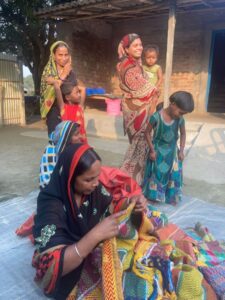Team L&M
Kheta, an exhibition of embroidery of the lesser-known reversible quilts, done by Shershabadi women from Kishanganj district of Bihar, begins tomorrow at the National Crafts Museum & Hastkala Academy, Bhairon Marg, Pragati Maidan, New Delhi. Many of the embroideries that are no more in practice will also be showcased in the exhibition.
Kheta is the cultural identity and embroidered expression of the migrant community of Muslims known as Shershabadi. Along with the exhibition, workshops will be held for educational institutions to learn the craft, there will be talks by experts, screening of films and audio-visual sessions to provide insights into the Shershabadi community and its culture. Kheta products will also be sold from the museum shop.
The exhibition is being held not just to bring to fore the unique art form, help towards economic empowerment of women artisans, but also work towards getting Geographical Indication (GI status) for it. The show also traces links between Bangladesh and India through the Shershabadi women.
The show is being jointly organised by Zameen Astar Foundation (ZAF) and Azad India Foundation (AIF) in association with its academic partner, Indian Institute of Art and Design (IIAD).

From the pages of history
The Shershabadi community initially settled in Malda district of Bangladesh on the land given by Emperor Sher Shah Suri (1486 AD – 1545 AD). The community later migrated, moving along the rivers and settled in the Kishanganj and neighbouring districts of Bihar and Bengal in India.
Even though it is a practicing craft in Kishanganj villages, Kheta remains undocumented in the family of recycled quilts from the Eastern part of India like Sujanis and Kanthas. In its intricate geometric patterning, Kheta stands out as an exquisite contemporary expression to the modern world.
Delicate yet densely patterned with vibrant colors, the Kheta embroidery is a kind of quilting (the art of stitching layers of fabrics) that has survived the onslaught of time and shares similar origin with other recycled quilting techniques like Kantha of Bengal and Sujni of Bihar.
Over the years, the Shershabadi community developed its own unique quilting technique of pure geometrical motifs, avoiding figurative depictions of Sujni and circular patterns of Kantha. It is generally used as a blanket for newborn children or a mattress for the newlywed couple
The show is on till April 3, 10:00 am to 5:00 pm.